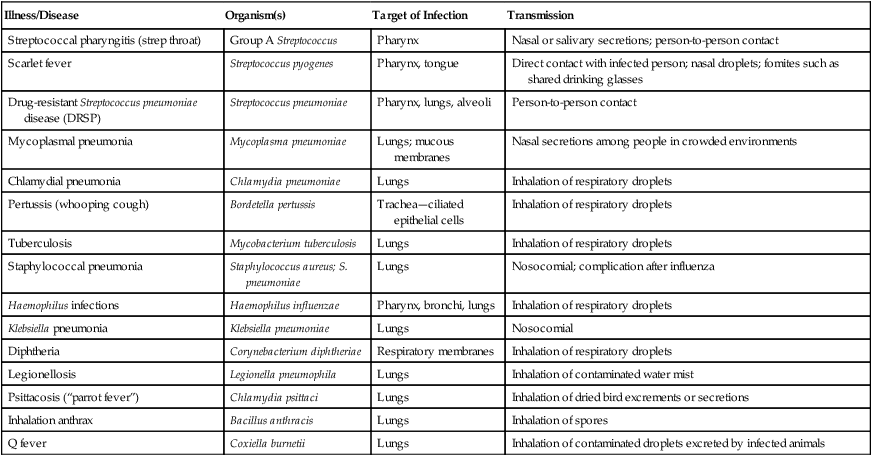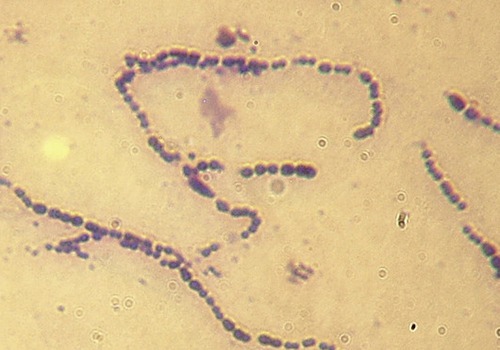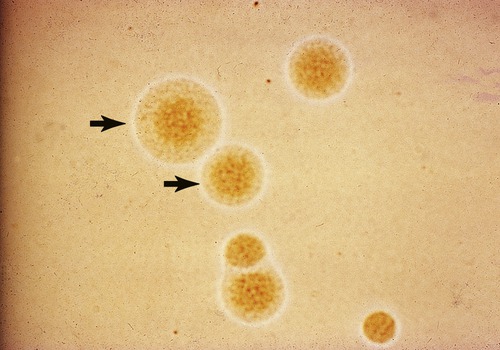Infections of the Respiratory System
After reading this chapter, the student will be able to:
• Name the criteria necessary for microbes to cause an infection of the respiratory system
• Identify the microbes typically present in the normal flora of the respiratory tract
• Name the different streptococcal respiratory infections; describe the transmission, symptoms, and treatment for each
• Discuss drug-resistant Streptococcus pneumoniae disease
• Describe the transmission and treatment of mycoplasmal and chlamydial pneumonias
• Discuss pertussis, tuberculosis, and their treatments
• Describe rare and opportunistic respiratory infections caused by bacteria
• Compare and contrast the common cold and influenza, and their prevention and treatment
• Describe infections of the respiratory system caused by fungi and the treatment of their infections
• Describe the common symptoms of upper and lower respiratory system infections, the possible treatments, and prevention
Introduction
The respiratory tract consists of the nasal cavity, the pharynx, larynx, bronchial tree, and lungs. Structurally and functionally the system can be divided into upper and lower respiratory systems (Figure 11.1).

The respiratory tract can be divided into the upper respiratory system, including the nose, pharynx, and associated structures; and the lower respiratory system, consisting of the larynx, trachea, bronchi, and lungs.
• The upper respiratory system includes the nose, pharynx, and associated structures.
• The lower respiratory system consists of the larynx, trachea, bronchi, and lungs.
The lining of the respiratory tract is a mucosal epithelium that serves as a barrier against microbial invasion; however, it is not as effective as an intact skin barrier. The mucosal lining of the respiratory tract has a moist and relatively warm environment suitable for microbes. Moreover, microbes may be trapped in the mucous layer and by way of the ciliary escalator transported to the pharynx and then swallowed. The normal flora (see Chapter 9, Infection and Disease) of the respiratory system contains a large number of bacteria that help to maintain a healthy state of the host by competing with potential pathogenic organisms. The microorganisms of the normal flora are usually harmless but they can become opportunistic pathogens when the host immune system is depressed, or when damage occurs to the mucosal membrane. Infections of the respiratory system can be caused by bacteria, viruses, and fungi. For an infection of the respiratory system to occur due to an exogenous agent the following criteria must be met:
• A sufficient number (dose) of infectious agent must be inhaled.
• The infectious agents must be airborne or contained in droplet nuclei.
• The infectious organism must remain alive and viable while in the air.
• The organism must find susceptible tissue in the host, suitable for attachment and growth.
• Once in the respiratory tract the organism must colonize the surfaces before it can cause disease.
Bacterial Infections
Bacterial infections of the respiratory tract can be caused by Staphylococcus, Streptococcus, Klebsiella, Haemophilus, Bordetella, Corynebacterium, Mycobacterium, Legionella, Mycoplasma, Chlamydia, and Coxiella. Infections caused by inhabitants of the normal flora can occur and appear as secondary infections after damage to the mucosal lining, usually caused by a viral infection such as the common cold. A summary of bacterial infections acquired through the respiratory system is given in Table 11.1.
TABLE 11.1
Bacterial Infections Acquired Through the Respiratory Tract
| Illness/Disease | Organism(s) | Target of Infection | Transmission |
| Streptococcal pharyngitis (strep throat) | Group A Streptococcus | Pharynx | Nasal or salivary secretions; person-to-person contact |
| Scarlet fever | Streptococcus pyogenes | Pharynx, tongue | Direct contact with infected person; nasal droplets; fomites such as shared drinking glasses |
| Drug-resistant Streptococcus pneumoniae disease (DRSP) | Streptococcus pneumoniae | Pharynx, lungs, alveoli | Person-to-person contact |
| Mycoplasmal pneumonia | Mycoplasma pneumoniae | Lungs; mucous membranes | Nasal secretions among people in crowded environments |
| Chlamydial pneumonia | Chlamydia pneumoniae | Lungs | Inhalation of respiratory droplets |
| Pertussis (whooping cough) | Bordetella pertussis | Trachea—ciliated epithelial cells | Inhalation of respiratory droplets |
| Tuberculosis | Mycobacterium tuberculosis | Lungs | Inhalation of respiratory droplets |
| Staphylococcal pneumonia | Staphylococcus aureus; S. pneumoniae | Lungs | Nosocomial; complication after influenza |
| Haemophilus infections | Haemophilus influenzae | Pharynx, bronchi, lungs | Inhalation of respiratory droplets |
| Klebsiella pneumonia | Klebsiella pneumoniae | Lungs | Nosocomial |
| Diphtheria | Corynebacterium diphtheriae | Respiratory membranes | Inhalation of respiratory droplets |
| Legionellosis | Legionella pneumophila | Lungs | Inhalation of contaminated water mist |
| Psittacosis (“parrot fever”) | Chlamydia psittaci | Lungs | Inhalation of dried bird excrements or secretions |
| Inhalation anthrax | Bacillus anthracis | Lungs | Inhalation of spores |
| Q fever | Coxiella burnetii | Lungs | Inhalation of contaminated droplets excreted by infected animals |

Streptococcal Infections
The genus Streptococcus is composed of spherical gram-positive bacteria well known for being responsible for “strep throat,” but is also capable of causing meningitis, pneumonia, endocarditis, erysipelas, necrotizing fasciitis (see Chapter 10, Infections of the Integumentary System, Soft Tissue, and Muscle), and toxic shock syndrome. The virulence of group A Streptococcus seems to be increasing worldwide.
Scarlet Fever
Scarlet fever is an upper respiratory disease also caused by an infection with a group A β-hemolytic streptococcus (Streptococcus pyogenes) (Figure 11.2) and once was a serious childhood disease but now is generally treatable. The incubation period is 1 to 2 days and typically begins with a fever and sore throat, but might also exhibit chills, vomiting, abdominal pain, and malaise. The exotoxin produced by the bacteria is responsible for the “strawberry” tongue (Figure 11.3) as well as the characteristic fine rash on the chest, neck, groin, and thighs. The treatment of scarlet fever is the same antibiotic treatment as for strep throat, and complications with appropriate treatment are rare.

This micrograph shows a Gram stain of S. pyogenes, a gram-positive coccus that is usually arranged in chains. This bacterium is typically found in the oral cavity and throat. The organism is responsible for a variety of infections including strep throat, tonsillitis, and necrotizing fasciitis.
Streptococcus pneumoniae
Streptococcus pneumoniae is a gram-positive, encapsulated α-hemolytic diplococcus (Figure 11.4), also known as pneumococcus, and is a common cause of mild respiratory illness, but also a major source of pneumonia. Other than pneumonia the organism is also capable of causing pharyngitis, sinusitis, otitis media, meningitis, osteomyelitis, septic arthritis, endocarditis, peritonitis, pericarditis, cellulitis, and brain abscess. S. pneumoniae is a common inhabitant of the nasopharynx of healthy people, but can be the cause of disease when the organism reaches other areas such as the eustachian tubes, nasal sinuses, and lungs. Furthermore the organism can be found in larger numbers in environments where people spend a lot of time in close proximity and it can be transmitted by person-to-person contact or by inhalation. If the organism is inhaled and not removed by the ciliary escalator (such as in smokers, in whom the cilia have been damaged or degenerated), or the mucous membranes are damaged by a viral infection, the bacteria can attach or even penetrate the mucosa. Once the organism succeeds in getting to a site where it normally is not found it will stimulate the immune system of the host, resulting in the attraction of leukocytes (see Chapter 20, The Immune System). The capsule of S. pneumoniae is resistant to phagocytosis and if immunity is not present the alveolar macrophages are incapable of destroying pneumococci. In this case the bacterium spreads into the bloodstream, where it most likely causes bacteremia. The organism then can get to other areas of the body, causing the conditions mentioned earlier. The virulence of S. pneumoniae is a direct result of its capsule and the encapsulated (smooth) strains are the ones causing disease, whereas the nonencapsulated (rough) strains are avirulent.


Streptococcus pneumoniae is a gram-positive coccus; the cocci are usually arranged in pairs (diplococci). In a large percentage of the population this organism is part of the normal flora of the mouth and throat; however, it can cause pneumonia. A, Dark-field image showing the diplo, or paired, arrangement of many of the cells. B, Capsule stain illustrating the arrangements of the cells and the thick capsule surrounding them.
Other Common Infections
Mycoplasmal Pneumonia
Mycoplasma pneumoniae, a small bacterium that lacks a cell wall (Figure 11.5), is the cause of primary atypical pneumonia, a relatively mild pneumonia, which usually affects people younger than 40 years of age. Transmission occurs by respiratory droplets through inhalation or person-to-person contact. The incubation period lasts 10 to 14 days and epidemics can occur, especially in crowded areas such as in schools, among military personnel, in homeless shelters, and within a family. Symptoms may last 1 to 3 weeks, starting with fatigue, a sore throat, and a dry cough. It resembles influenza at the beginning, followed by worsening of the cough, which eventually produces sputum. Although it is usually a mild condition and most people recover without treatment, severe cases require antibiotic treatment. It should be noted that because of the lack of a cell wall these organisms are resistant to penicillin and other β-lactam antibiotics (see Chapter 22, Antimicrobial Drugs), which act by interrupting the formation of peptidoglycan cross-links of bacterial cell walls.

Mycoplasma pneumoniae is a small bacterium that lacks a cell wall and is responsible for an estimated 2 million cases of pneumonia in the United States annually, including approximately 100,000 hospitalizations. (From Forbes BA, Sahm DF, Weissfeld AS: Bailey & Scott’s diagnostic microbiology, ed 12, St. Louis, 2007, Mosby.)
Pertussis (Whooping Cough)
Pertussis, also known as whooping cough, is a highly contagious disease caused by Bordetella pertussis, an extremely small, aerobic, gram-negative coccobacillus (Figure 11.6). It is a serious disease that can cause permanent disability and even death. Pertussis is easily spread from person to person by airborne droplets discharged from the mucous membranes of infected people. Initial symptoms occur about a week after exposure and resemble those of the common cold. The severe coughing spells start approximately 10 to 12 days later and these spells may lead to vomiting. The coughing often ends with a “whoop” noise caused when the patient is trying to take a breath. Despite the availability of, and high coverage with vaccines, pertussis is one of the leading causes of vaccine-preventable deaths worldwide. Ninety percent of all cases occur in the underdeveloped countries and most deaths involve infants who are either not vaccinated or incompletely vaccinated. Treatment with effective antibiotics, if started early, shortens the infectious period but usually does not alter the outcome of the disease.



